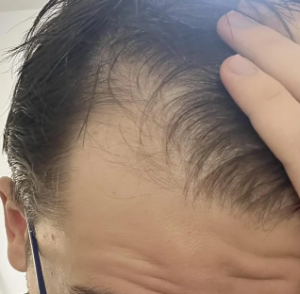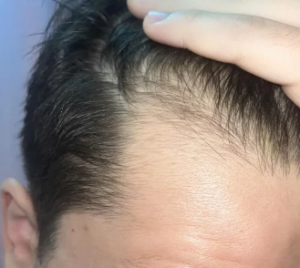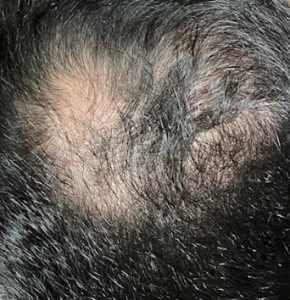DUPA (Diffise UnPatterned Alopecia) is fairly uncommon. The diagnosis is always made by examining the hair in the back of the head with a hand microscope (Trichoscope). Here is an example of what it looks like: https://baldingblog.com/do-i-have-dupa-photo/
Please look carefully at this picture. You can see that the donor density is clearly less dense than in the upper left corner, an area that was not harvested. People always ask me what is my total donor supply; well, this picture shows that with enough harvesting, the donor area becomes so thin that one can call it depleted of hair, thin enough to be visibly observed. FUE thins the donor area 100% of the time; however, there is some grafts that can be removed that will not cause significant visual depletion, as shown in this man. How many grafts can be harvested before the donor area looks depleted, like in this man? That depends on at least two major factors and some minor factors as well.
1- Major Factors:
a) Remaining hair follicles. The average Caucasian man has 27,500 hairs in his donor area or about 12,500 grafts. If the hair count is reduced by over 50% in an average-weight hair (50-micron thickness), then depletion starts to appear the more the hair count goes down.
b) Hair thickness: The coarser the hair, the more hairs can be removed from the donor area. A person with a hair thickness of 75 microns can probably lose 60-70% of their hair before donor depletion is an issue; however, if the hair thickness is 30 microns, then the loss of 50% of the donor hair will certainly look depleted.
2- Minor Factors:
a) Hair vs skin color. The closer the hair color is to the skin color, then more hair can be safely removed from the donor area; however, when the contrast is high (black hair against white skin), then the number of hair left behind must be higher than 50%.
b) Character of the hair: Straight hair may not be as good in coverage, especially if it is fine in character, while wurly or kinky hair covers well behind each single hair shaft.
Here is an example of a man who had too many hairs removed from his donor area. The only want to treat this is to (1) grow the hair longer in the hope that longer hair will act like shingles to cover the spaces where it used to be or (2) use SMP to change the color and of the spaces in the donor area with what appears to be cut hair follicles.
If you switch from fin to Dut, do you still have to wait ~12months to see progress?
Switching from finasteride to dutasteride just increases the effectiveness by 15% at most. Usually, you will see any benefits in about 3 months if you have been on finasteride for at least 6-9 months at the time of the switch. That is not saying that you will see any benefits regardless of how long you wait.
I have heard that over and over again in my 30 years in the hair practice. Finasteride is always working, it may just be slowing the hair loss down less than it did before because your balding became more progressive. Unfortunately, to prove that I am right, you would have to stop finasteride and you will see massive hair loss, what I call catch-up hair loss. Too many men have done this and they regretted it.
You need your donor area examined with a video microscope and get a hair count and a measurement of the thickness of your hair. You want to make sure that you don’t have DUPA which can be diagnosed with the hand microscope. If you want to know your original donor density and your Hair Mass Index along with your total available donor graft supply for your lifetime, see an expert in the field. I wrote extensively about this here: https://baldingblog.com/donor-density-is-counting-hairs-with-macro-lens-on-cell-phone/
Hello doctor, thanks for your time. Doctor a question, in YOUR clinical experience, NOT in studies, only in your experience… what percentage of your patients get side effects from Finasteride that you suspect is NOT Nocebo?
I think that the sexual side effects in my patients over the age of 30, is about 4%. Many of the younger men are getting their information from forums and blogs that emphasize sexual side effects as almost expected. In these younger men, the incidence is higher.
Will starting minoxidil worsen my natural hair? Do the minoxidil supported hairs steal nutrients from weaker non minoxidil supported ones – meaning if you stop minox you’ll be bellow starting baseline or am I mistaken? I am already on 1.25 fin EOD so in theory my existing hairline should maintain/not effected by MPB.
Thank you in advance!
No. Minoxidil works to grow hair because it is a known side effect of the drug. Originally the drug was marketed for hair blood pressure but found not reliable as better drugs came to market. Women notice that it grew facial hair and didn’t like that side effect
From what I’ve seen, it seems like hair miniaturization progresses over several hair cycles and happens after a hair sheds. Is this the only way that it can occur? I have semi-long hair and I’ve noticed that the hair I shed appears to get thinner over time, as in it tapers from thick to thin towards the root – is this hair miniaturization? If so, what makes this different from “normal” miniaturization?
Yes, a miniaturized hair can regrow again and then undergo further miniaturization. I have seen single hair shafts that are thinner at the exit point in the scalp then they are at the long end.
I see a lot of people who use derma rolling/stamping. Creating small holes in my head feels like it mainly creates damage. Can somebody explain me what it is used for and how it should improve the hair situation?
Reddit posted a full ‘How to Do Microneedling’ here: https://www.reddit.com/r/tressless/wiki/microneedling/
When microneedling is done correctly (controlled damage performed at least 10 seconds in each spot you need the hair to return). The Dr. Pen device offers the best product (see Amazon) as you can get the 34 needle type, length 1.25mm and use it from place to place until you cover your entire area that you are hoping to get your hair back. Once a week seems to be the most effective timing. The wounds that are created, are near the stem cells that trigger hair cycling. These cells don’t like the constant wounds, so they react with wound healing, a component of it impact the stem cells to trigger hair growth as part of the cytokine response by the body to the healing process.
So I started oral min like a week and a half ago. After like 10 months on topical min. Seeing tons of new hairs around my eyebrows and even some baby hairs on my hair line. Does this mean my hair in my head is also growing ? Can you get new body hairs but no regrowth on ur hair ? I can’t tell but I’m seeing a ton of growth everywhere hopeful for my diffuse thinning problem?
Did you take before photos to compare now vs 10 months ago? How bad was your balding? If it was only some thinning, maybe you might not have recognized hair growth. The fast that you got hair growth elsewhere suggests that you should have seen in in the scalp.
I’ve been relatively stable on oral fin and topical min for past 6 years but noticed increased temple and hairline recession in the past year. Thought dut was next best step but not only did I have testicular pain (which I had on fin) but pain in penis which I’ve never had before on fin so it scared me considering the strong half life of dut. Is oral min my next best step? I have no idea if topical min has been effective for me since I started at same time as fin.
Treating yourself doesn’t sound good to me. Now with dutasteride on board (that is what I think you said), it may take 4-10 months to lose the side effects, unlike finasteride which is much less time to reverse as the half life is only 4-6 hours rather than 5 weeks as with dutasteride. A reasonable alternative may be oral minoxidil, but the real oral minoxidil, not taking drops of the topical and sallowing it. You might consider getting a real doctor to manage your hair loss.
Not a good idea as the pill can absorb water out of the atmosphere.
How long after stopping finasteride did it take to recover from sides?
Everyone seems to take a different amount of time to reverse finasteride side effects when stopping the drug. The range in my experience relates to how long you have been on the drug. The range is between 2 – 16 weeks.
Page 54 of 1234





